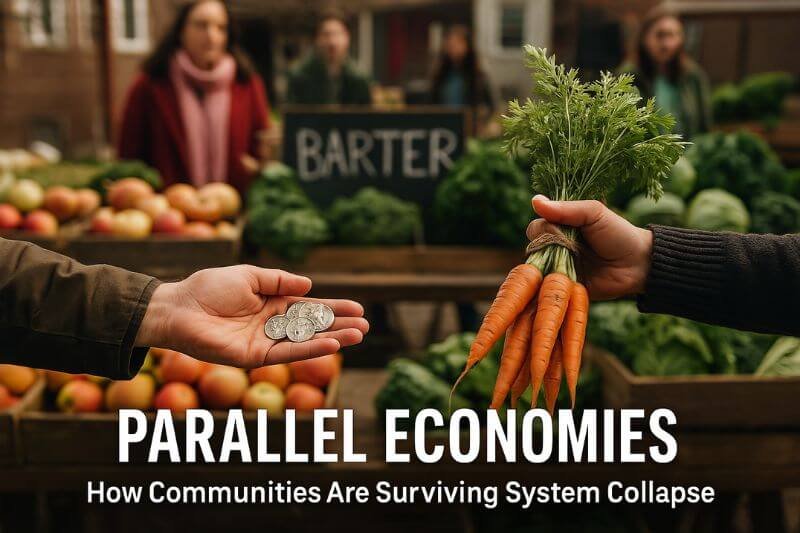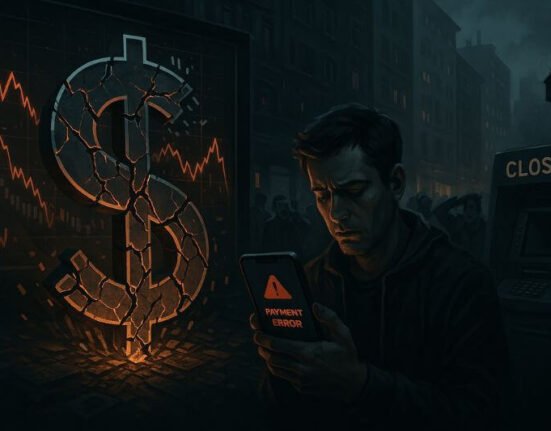How Communities Are Surviving Outside the System
When the Official Economy Fails, People Build Their Own
In Lebanon, a bag of flour is now worth more than a month’s salary. In Argentina, bartering has replaced credit cards. Across parts of Africa and Southeast Asia, communities are surviving without banks, governments, or traditional markets.
This isn’t fiction—it’s the rise of parallel economies.
As inflation spirals, trust in fiat collapses, and state systems fail to deliver, more people are turning to alternative economic models to survive. From barter networks to crypto cooperatives, humanity is rebuilding value systems from the ground up.
And for survivalists, understanding these systems is no longer optional—it’s vital.
What Are Parallel Economies?
Parallel economies operate outside or alongside official government-regulated financial systems.
They can include:
- Barter networks
- Alternative currencies
- Local or off-grid markets
- Decentralized trading systems
- Underground labor exchanges
Often seen as informal or “black market” by authorities, these economies are resilience engines in times of collapse.
🔍 Focus Keyword: parallel economies
Why Are They Emerging Globally?
1. Inflation and Currency Collapse
When national currencies lose value, people turn to trade systems based on real goods, skills, or stable assets.
Examples:
- Venezuela: hyperinflation pushed citizens to barter food and fuel
- Zimbabwe: U.S. dollars and gold coins replace local currency
- Turkey: gold-based savings and trade networks have grown massively
2. Distrust in Governments and Institutions
Corruption, mismanagement, and control measures drive populations toward community-based systems they can trust.
- Argentina (2022–2024): bartering co-ops exploded after the peso crashed
- Nigeria: central bank limits on ATM withdrawals sparked cash-free street economies
3. Digital Centralization Backlash
Central Bank Digital Currencies (CBDCs) and surveillance finance have created fear around state-controlled money.
In response:
- Communities form cash-only enclaves
- Crypto-based trade hubs emerge
- Privacy coins (Monero, Zcash) become survival tools
How Parallel Economies Work in Practice
They vary by culture and region, but most share common traits:
✅ Trust-Based
Transactions rely on reputation and local networks, not institutions.
✅ Decentralized
No central authority governs rates or value—the community decides.
✅ Flexible
People trade time, labor, goods, or services without needing currency.
✅ Invisible (to the system)
No taxes, no tracking, no bank approvals.
Real-World Examples of Parallel Economies
1. El Trueque – Argentina’s Barter Clubs
Started during the 2001 collapse and revived in 2022, “El Trueque” lets people:
- Exchange food, clothes, tools, services
- Use barter tokens pegged to hours of labor
- Operate via public plazas, garages, or churches
Today, over 6 million Argentines use these systems weekly.
2. The Lebanese Dollar Crisis Response
After banking restrictions and inflation:
- Citizens used WhatsApp barter groups
- Gold coins and pre-USD cash reemerged
- Farmers began direct milk-for-fuel trades
3. African Mobile Money Circuits
In Kenya, Ghana, and Nigeria:
- Communities use offline phone systems (USSD) to manage balances
- People create private lending groups with no bank involvement
- Barter, airtime, and “mobile tokens” replace fiat in rural zones
4. Urban Off-Grid Markets in the U.S.
Post-COVID, many U.S. cities saw:
- Cash-only produce and meat sales
- Bartering meetups via Telegram and Craigslist
- Crypto for food or ammo transactions in prepper groups
What Do Survivalists Learn from These Models?
Parallel economies reveal how resilient humans become when systems fail. They show:
- How to value resources over currency
- How to rebuild trust-based trade
- How to thrive when banks and supply chains collapse
They also allow prepared communities to insulate themselves from central control.
How to Build or Join a Parallel Economy
Whether collapse hits slow or fast, you can start preparing now.
1. Build Local Barter Networks
✅ Organize:
- “Swap Saturdays” in your area
- Telegram/Signal group for trade offers
- Paper catalogs of goods and skills
Start small: seeds, soap, firewood, eggs, batteries
2. Create Your Own Currency
Use:
- Labor tokens (1 token = 1 hour of skilled work)
- Barter coins (metal slugs, poker chips, wooden credits)
- Trust logs (digital or physical ledger of who owes what)
Tip: Keep it transparent, tracked, and easy to understand.
3. Diversify Your Assets
✅ Hold:
- Junk silver coins (pre-1965 U.S. quarters/dimes)
- Trade goods: alcohol, ammo, soap, seeds
- Privacy crypto: Monero, DAI, Bitcoin Cash (offline wallets)
Barter works when people need what you have.
4. Practice Skill-for-Skill Trading
Your skills are your currency.
Learn to:
- Repair electronics
- Grow mushrooms or microgreens
- Make herbal medicine
- Fix bicycles or engines
- Butcher or smoke meat
Offer your skills in trade before they’re needed.
5. Stay Invisible, Stay Secure
Parallel economies attract unwanted attention from:
- Governments
- Tax agencies
- Criminal groups
✅ Use:
- Pseudonyms
- Encrypted communication
- No digital receipts
- Low-profile trades
Legal Risks of Parallel Economies
In many countries, parallel economies are not illegal—until they threaten state control.
Risks include:
- Being labeled “black market”
- Tax evasion investigations
- Confiscation of trade goods
- Surveillance or infiltration
Always operate with discretion and local awareness.
Parallel Economies and Crisis Resilience
They don’t just help you survive collapse—they help you outlast and rebuild.
Benefits include:
- Strengthened community ties
- Decreased dependency
- Economic insulation
- Local empowerment
In many ways, parallel economies are the blueprint for long-term survival.
Are You Ready to Trade Outside the System?
Collapse isn’t always explosive. Sometimes it creeps in—through shortages, controls, inflation, or apathy.
Parallel economies aren’t just “alternatives”—they’re future-proof models.
Start building now:
- Trade knowledge
- Build trust
- Decentralize your value
Because when the grid goes down, the trade circle lights up.












